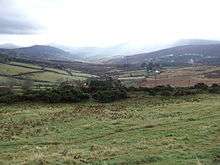Glencree

Glencree (Irish: Gleann Crí) is a valley in the Wicklow Mountains in eastern Ireland. It is the second closest valley in the mountains to Dublin city, the first being Glencullen. The River Dargle flows down the valley, which rises to a height of about 400 metres (1,312 feet). The foot of the valley is site of the village of Enniskerry.
The barracks
The top of the glen emerges onto the military road, constructed by the British Army in the early 19th century in order to hunt down the United Irishmen guerrillas, holding out in the mountains after the Irish Rebellion of 1798. A barracks was built at Glencree, just off the road in 1806. With the end of the Napoleonic Wars in 1815, the building was vacated by the British Army.
In 1858 the buildings were converted into a reformatory school. St. Kevin’s Reformatory was operated by the Oblates of Mary Immaculate (OMI). It closed in 1940.[1]
It was used to house German prisoners of war during the First World War 1914-18, when Ireland was still part of the United Kingdom. During the Second World War, 1939–45, when Ireland was neutral, Glencree housed German Air Force pilots who crashed in Ireland as well as German agents who were captured trying to plan anti-British activities with the IRA.
Under Operation Shamrock the Irish Red Cross and the French Sisters of Charity cared for German and Polish war orphans here from 1945 to 1950.
The Glencree Centre for Peace and Reconciliation opened in 1975 to foster better relations between the two communities in Northern Ireland. Currently, they run a broad range of programmes aimed at bringing various actors from global conflict zones to the valley. At present, there are programmes serving youth, women, ex-combatants, the churches, victims and political/economic leaders. Also, the centre provides training in mediation and conflict resolution, as well as hosting a summer school each year on a topic of relevance to the Irish conflict and society. Of late, they have begun broadening their reach to include actors from other global conflicts, most notably from the Middle East, Sri Lanka and Haiti. Finally, the centre runs a volunteer programme that invites adults from around the world to serve from 2 months to one year on programme and service work. From September 2007, volunteers have fulfilled only menial tasks, with six interns working on the programmes. On the site, there is a gift and coffee shop. When programmes are not in session, the rooms are rented in hostel-style.
German War Cemetery
Glencree German War Cemetery (German: Deutscher Soldatenfriedhof) was dedicated on 9 July 1961. There are 134 graves. Most are Luftwaffe (air force) or Kriegsmarine (navy) personnel. 53 are identified, 28 are unknown. Six remains belong to World War I prisoners of war held by the British. Forty six were German civilian detainees, who were being shipped from Britain to Canada for internment when their ship, SS Arandora Star was torpedoed by a German U-boat, U-47, off Tory Island, County Donegal, on July 1940. Dr. Hermann Görtz, an Abwehr spy, is also buried there. Dr. Görtz, who committed suicide after the war, feared he would be handed over to the Soviet Union.
It is administered by the German War Graves Commission (Volksbund Deutsche Kriegsgräberfürsorge).[2]
Alongside the German Cemetery, on the bank of the Glencree River, a Mass rock is located. It may be reached by a narrow riverside path.
Grotto
In the valley, where the Glencree River (little more than a stream) flows, there is a grotto dedicated to Our Lady of Reconciliation.
Youth hostel
There was previously a youth hostel some metres outside the Glencree gates. The mountains around Glencree are popular for walking.[3] This hostel, operated by An Óige since 1950, was sold 2 May 2006. Hostel-style accommodation is now available in the Centre for Reconciliation.
Films shot in Glencree
- Casino Royale (1967)
- Where's Jack? (1969)
- Zardoz (1973)
- The First Great Train Robbery (1978)
- Green Journey (1990)

References
| Wikimedia Commons has media related to Glencree_German_War_Cemetery. |
Websites
- Glencree German Cemetery
- Glencree Centre for Reconciliation
- Irish Mountain Running Association
- RTÉ Radio 1 programme on Glencree Valley http://www.rte.ie/radio1/shanksmare/rams/2006/23june.smil
Coordinates: 53°11′N 6°15′W / 53.183°N 6.250°W